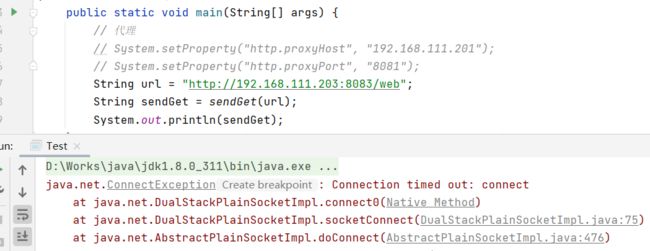http正向代理测试,nginx反向代理中转正向代理服务器
有3台服务器如下:
192.168.111.201(反向代理到正向代理服务器)
192.168.111.202(正向代理服务器)
192.168.111.203(目标WEB系统)
防火墙网络策略如图所示:
1、192.168.111.200 只能访问 192.168.111.201 的 8081端口。
2、192.168.111.201 只能访问 192.168.111.202 的 8082端口。
2、192.168.111.202 只能访问 192.168.111.203 的 8083/8084/8085端口。
目标:
本地192.168.111.200 发送http请求 http://192.168.111.203:8083/web 能够返回结果。
一、网络策略
1、192.168.111.201 开放8081端口
#清空防火墙规则
mv public.xml public.xml.bak
systemctl restart firewalld
#开启端口
firewall-cmd --permanent --add-port=8081/tcp
#重新加载生效
firewall-cmd --reload
#查询有哪些端口是开启的
firewall-cmd --list-port2、192.168.111.202 只对 192.168.111.201 开放8082端口
#清空防火墙规则
mv public.xml public.xml.bak
systemctl restart firewalld
#只允许192.168.111.201访问8082端口,注意这里有两个port不是写错了
firewall-cmd --permanent --add-rich-rule='rule family=ipv4 source address=192.168.111.201 port port=8082 protocol=tcp accept'
#重新加载生效
firewall-cmd --reload
#查看规则
firewall-cmd --list-rich-rules
#删除规则
firewall-cmd --permanent --remove-rich-rule='' 3、192.168.111.203 只对 192.168.111.202 开放8083端口
#清空防火墙规则
mv public.xml public.xml.bak
systemctl restart firewalld
#只允许192.168.111.202访问8083端口,注意这里有两个port不是写错了
firewall-cmd --permanent --add-rich-rule='rule family=ipv4 source address=192.168.111.202 port port=8083 protocol=tcp accept'
#重新加载生效
firewall-cmd --reload
#查看规则
firewall-cmd --list-rich-rules
#删除规则
firewall-cmd --permanent --remove-rich-rule='' 测试网络策略
#安装telnet客户端
yum -y install telnet.*
telnet 192.168.111.202 8082 只有192.168.111.201通
telnet 192.168.111.203 8083 只有192.168.111.202通
二、192.168.111.201
安装 nginx
# 安装四个依赖
yum -y install gcc zlib zlib-devel pcre-devel openssl openssl-devel
# 有些系统还需要多安装几个依赖
# yum -y install make gcc-c++ libtool
yum -y install wget
wget http://nginx.org/download/nginx-1.13.7.tar.gz
tar -zxvf nginx-1.13.7.tar.gz
cd nginx-1.13.7
./configure --prefix=/usr/local/nginx --with-stream
make && make install修改配置 vi /usr/local/nginx/conf/nginx.conf,反向代理到 192.168.111.202
stream {
server {
listen 8081;
proxy_pass 192.168.111.202:8082;
}
}
启动nginx
cd /usr/local/nginx/sbin/
./nginx三、192.168.111.202
部署正向代理服务器
package com.study.proxy;
import org.slf4j.Logger;
import org.slf4j.LoggerFactory;
import java.io.ByteArrayOutputStream;
import java.io.IOException;
import java.io.InputStream;
import java.io.OutputStream;
import java.net.ServerSocket;
import java.net.Socket;
import java.net.URL;
import java.nio.charset.StandardCharsets;
import java.util.StringTokenizer;
import java.util.concurrent.ExecutorService;
import java.util.concurrent.Executors;
/**
* 正向代理
* @Date: 2023/11/20 14:49
*/
public class Proxy {
private static Logger logger = LoggerFactory.getLogger(Proxy.class);
public static void main(String[] args) throws Exception {
startProxyServer();
}
// 启动代理服务器
public static void startProxyServer() {
new Thread(new ProxyServer()).start();
}
// 代理服务器
static class ProxyServer implements Runnable {
@Override
public void run() {
try {
// 监听指定的端口
int port = 8082; //一般使用49152到65535之间的端口
ServerSocket server = new ServerSocket(port);
// 当一个ServerSocket关闭并释放其绑定的端口后,操作系统通常会在几分钟内不允许其他Socket再次绑定到该端口。
// true:操作系统将允许其他Socket立即绑定到刚刚被释放的端口。
server.setReuseAddress(true);
// 使用线程池,防止过多线程耗尽资源
ExecutorService threadPool = Executors.newFixedThreadPool(50);
while (true) {
Socket socket = server.accept(); //会一直阻塞,直到有客户端连接进来
// new Thread 只是创建一个类的对象实例而已。而真正创建线程的是start()方法。
// 这里并没有直接调用start()方法,所以并没创建新线程,而是交给线程池去执行。
threadPool.submit(new ProxyClient(socket));
}
} catch (Exception e) {
logger.error("ProxyServer", e.getMessage(), e);
}
}
}
// 代理客户端
static class ProxyClient implements Runnable {
private final Socket proxySocket;//代理Socket
private Socket targetSocket = null;//目标Socket
public ProxyClient(Socket socket) {
this.proxySocket = socket;
}
@Override
public void run() {
try {
//客户端请求的报文
InputStream req = proxySocket.getInputStream();
int read;
int contentLength = 0;//body长度
String method = null;//请求方法
String url = null;//请求地址
String protocol = null;//请求协议
ByteArrayOutputStream os = new ByteArrayOutputStream();
ByteArrayOutputStream reqBack = new ByteArrayOutputStream();
//解析,提取请求报文
while ((read = req.read()) != -1) {
os.write(read);
reqBack.write(read);
if (read == '\n') {
//CONNECT www.xx.com:443/xx/yy HTTP/1.1
String line = os.toString("UTF-8");
os.reset();//重置,以便再次使用
if ("\r\n".equals(line)) {
//空行,请求头结束标志
break;
}
StringTokenizer stringTokenizer = new StringTokenizer(line, " ");
if (method == null) {
//八种请求方法:GET、POST、HEAD、OPTIONS、PUT、PATCH、DELETE、TRACE、CONNECT 方法
method = stringTokenizer.nextToken().toLowerCase();//connect
url = stringTokenizer.nextToken();//www.xx.com:443/xx/yy
protocol = stringTokenizer.nextToken().trim();//HTTP/1.1
} else {
String key = stringTokenizer.nextToken().toLowerCase();
if ("content-length:".equals(key)) {
String value = stringTokenizer.nextToken().trim();
contentLength = Integer.parseInt(value);
}
}
}
}
if (contentLength > 0) {
for (int i = 0; i < contentLength; i++) {
reqBack.write(req.read());
}
}
//完整请求报文
// String request = reqBack.toString("UTF-8");
// System.out.println("请求报文开始");
// System.out.print(request);
// System.out.println("\r\n请求报文结束");
//拼接完整url
if (url != null && !url.startsWith("http")) {
url = method.equals("connect") ? "https://" + url : "http://" + url;
}
URL u = new URL(url);
//目标ip
String targetHost = u.getHost();
//目标端口
int targetPort = u.getPort();
if (targetPort == -1) {
targetPort = 80;
}
//目标Socket
targetSocket = new Socket(targetHost, targetPort);
if ("connect".equals(method)) {//https
//HTTP/1.1 200 Connection established
//报文直接发送给代理Socket
OutputStream outputStream = proxySocket.getOutputStream();
outputStream.write((protocol + " 200 Connection established\r\n").getBytes(StandardCharsets.UTF_8));
outputStream.write("Proxy-agent: ProxyServer/1.0\r\n".getBytes(StandardCharsets.UTF_8));
outputStream.write("\r\n".getBytes(StandardCharsets.UTF_8));
outputStream.flush();
//前者转发给后者,代理Socket转发给目标Socket
Thread proxy2target = new Thread(new ForwardData(proxySocket, targetSocket));
proxy2target.start();
//前者转发给后者,目标Socket转发给代理Socket
Thread target2proxy = new Thread(new ForwardData(targetSocket, proxySocket));
target2proxy.start();
proxy2target.join();
} else {//http
//请求报文转发给目标Socket
OutputStream outputStream = targetSocket.getOutputStream();
outputStream.write(reqBack.toByteArray());
outputStream.flush();
//前者转发给后者,目标Socket转发给代理Socket
Thread thread = new Thread(new ForwardData(targetSocket, proxySocket));
thread.start();
thread.join();
}
} catch (Exception e) {
logger.error("ProxyClient", e.getMessage(), e);
} finally {
try {
if (targetSocket != null) {
targetSocket.close();
}
} catch (IOException e) {
logger.error("ProxyClient", e.getMessage(), e);
}
try {
if (proxySocket != null) {
proxySocket.close();
}
} catch (IOException e) {
logger.error("ProxyClient", e.getMessage(), e);
}
}
// logger.error("ProxyClient", "结束");
}
// 转发数据
static class ForwardData implements Runnable {
private final Socket inputSocket;
private final Socket outputSocket;
public ForwardData(Socket inputSocket, Socket outputSocket) {
this.inputSocket = inputSocket;
this.outputSocket = outputSocket;
}
@Override
public void run() {
try {
InputStream inputStream = inputSocket.getInputStream();
OutputStream outputStream = outputSocket.getOutputStream();
int read;
while ((read = inputStream.read()) != -1) {
outputStream.write(read);
}
} catch (Exception e) {
// logger.error("ForwardData", inputSocket + e.getMessage());
}
}
}
}
}
四、192.168.111.203
部署目标web服务
@RestController
public class WebController {
@GetMapping("/web")
public String web() {
return "ok";
}
}五、本地测试
package com.study.client;
import java.io.ByteArrayOutputStream;
import java.io.IOException;
import java.io.InputStream;
import java.net.HttpURLConnection;
import java.net.URL;
/**
* 测试
*/
public class Test {
public static void main(String[] args) {
// 正向代理服务器
System.setProperty("http.proxyHost", "192.168.111.201");
System.setProperty("http.proxyPort", "8081");
// 目标地址
String url = "http://192.168.111.203:8083/web";
String sendGet = sendGet(url);
System.out.println(sendGet);
}
public static String sendGet(String url) {
HttpURLConnection con = null;
InputStream is = null;
try {
con = (HttpURLConnection) new URL(url).openConnection();
is = con.getInputStream();
ByteArrayOutputStream baos = new ByteArrayOutputStream();
byte[] buf = new byte[1024];
int len;
while ((len = is.read(buf)) != -1) {
baos.write(buf, 0, len);
baos.flush();
}
return baos.toString("UTF-8");
} catch (Exception e) {
e.printStackTrace();
} finally {
try {
if (is != null) {
is.close();
}
if (con != null) {
con.disconnect();
}
} catch (IOException e) {
e.printStackTrace();
}
}
return null;
}
}
运行结果:
注释代理,连接超时


